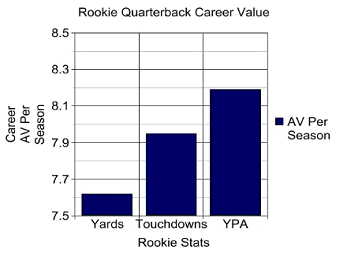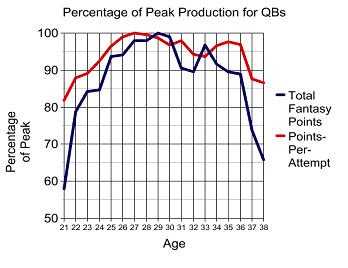Jonathan Bales is the author of the Fantasy
Football for Smart People book series. He writes for the New
York Times, DallasCowboys.com, NBC, and Dallas Morning News.
The consensus view on fantasy quarterbacks has come a long way in
just one year; whereas it was “common knowledge” that
you needed to grab an elite quarterback in 2012, it’s very
in vogue to wait on the position this year.
Regardless of your strategy, you still want to acquire the best
possible value with each pick. That’s easier said than done,
especially at a position as consistent as quarterback. Because the
quarterback standings typically don’t change that much from
year to year, most owners tend to have similar quarterback rankings.
The key, then, is identifying predictors of success that will allow
you to “buy low” on an undervalued asset.
In writing my fantasy football books, my goal was to research all
sorts of fantasy football “truisms” to see which stand
up to testing and which are fantasy football folklore. I found that
players don’t really break out in contract seasons, nor do
running backs actually break down after heavy workloads, for example.
In the revised edition of Fantasy
Football for Smart People: How to Dominate Your Draft, I used
all of the information I uncovered to build the “prototypical”
player at each position. Which players need to be fastest? Biggest?
The results were pretty surprising. To help you generate as much
value as possible from your signal-caller in 2013, check out the
section on how to build the prototypical fantasy football quarterback.
For years, pocket passers ruled the NFL. Nowadays,
more and more quarterbacks are mobile, running the read-option and
using their legs to secure big plays for their teams. While debates
will rage on regarding the “better” system, some of
today’s young quarterbacks are so talented that they can do
both—stand in the pocket to deliver passes with pinpoint accuracy,
or use their mobility to steal the show on the ground.
That got me to thinking: if the “ideal” quarterback
can beat defenses in a number of ways, what other traits might he
possess?
Mobility Isn’t Essential,
But It’s Ideal
All quarterbacks need to be able to throw with accuracyóthatís not
up for debateóbut the rookies who have found recent NFL success
have all been able to make plays with their legs. Robert Griffin
III, Russell
Wilson, Cam
Newton, and even Andrew
Luck have already turned in some of the top quarterback rushing
performances of all-time. When selecting a quarterback, try to target
one who can give you points as a runner; it increases his value
because itís a trait thatís often overlooked in drafts, and it decreases
week-to-week volatility.
Efficiency > Bulk Stats as a Predictor
Most fantasy owners pay for bulk stats, and for obvious reasons.
You clearly want a quarterback who will throw for a lot of yards
and touchdowns, but itís difficult to acquire value by emphasizing
those stats since everyone else is doing the same. To truly obtain
value, you need to search for predictors of future success, especially
for quarterbacks who have yet to break out. Yards-per-attempt is
the best of the bunch.
YPA actually predicts future production far better than touchdowns
or yards.

Thatís pretty surprising, and it provides an opportunity for you
to exploit the tendency of others to pay for yards and touchdowns.
When others are jumping on Andrew
Luck (6.98 YPA), you can get Ryan Tannehill (6.81 YPA)ónow equipped
with new weapons on the outsideóat a bargain.
35 Is the New 25
Thereís no single trait thatís as overlooked as much as player age.
Below, I charted historic quarterback production, in terms of total
points and points-per-attempt, at each age.

Quarterback production tends to peak around age 29, but most passers
reach near-peak efficiency in their mid-20s. Trading for or drafting
a quarterback around age 25 is often a winning proposition because
his future outlook is brighter than his past production. Meanwhile,
try to avoid quarterbacks who have just turned 30, as most see a
slight dip in efficiency and total production in the coming years.
After that decline, though, most of the gameís top quarterbacks
maintain a relatively high level of play well into their 30sómeaning
a 36-year old probably isnít much worse off than a 31-year old.
Airing It Out
Quarterbacks are like running backs in that they need a heavy workload
in order to post big-time fantasy production. Thatís because the
standard deviation of quarterback YPA is minimal; although itís
a good predictor of success, the best quarterbacks typically average
only a yard or so more per pass than mediocre ones. Meanwhile, some
quarterbacks can throw 300 more passes than others, and no realistic
amount of efficiency can make up for that. Ideally, youíd like a
quarterback in a pass-heavy offense whose attempts wonít be capped
at 30 per game.
Bringing it Together in 2013
Letís assume that weíre using a late-round quarterback
strategy this year. Which passers with a current ADP in the seventh
round or later best match our criteria? Letís first look at
just age and mobility:
Right away, we can take out all passers except RGIII, Luck, Wilson,
Tannehill, and Smith. That’s not to say the eliminated quarterbacks
can’t offer value, but rather that they don’t match
the prototype of past elite passers.
Four of the five players we’ve selected were rookies in 2012,
so their first-year efficiency is relevant to us. Luck and Tannehill
were both efficient as far as first-year quarterbacks go, but RGIII
and Wilson were off of the charts. Smith’s rookie stats really
don’t matter much anymore, but he was highly efficient during
his last few seasons in San Francisco.
Despite their efficiency, I have reservations about both RGIII and
Wilson. The problem is that it’s unlikely they’ll be
more efficient in 2013, but we’re not really sure if their
workloads will increase. Wilson’s attempts could jump, but
he’s also not going to throw a touchdown on 6.6 percent of
his attempts like he did as a rookie. Plus, Griffin is an injury-risk
I’m not willing to take in the seventh round.
Luck’s efficiency will almost assuredly improve in his second
year in the league, but can we count on another top five season
in terms of attempts? Probably not. On the other hand, Tannehill
was nearly just as effective as Luck on a per-throw basis, but he
threw almost 200 fewer passes. With Miami’s commitment to
the passing game and Tannehill’s continued development as
a quarterback, he’s basically a less-hyped version of Luck—young,
relatively mobile, and efficient—but with a much cheaper price
tag. Smith is in a similar situation; he’s still just 29 years
old, so he should be able to produce at near-peak efficiency, and
he’s probably going to see a massive upswing in attempts in
Kansas City.
I’m not saying you should draft just Tannehill and Smith and
think you’ll ride them to a fantasy championship, but both
players make for excellent under-the-radar additions. They’re
high-upside options, which is what you want in the late rounds.
And if it doesn’t work out, you’ll lose a 14th or 15th-round
pick, not a sixth or seventh.
Check out all
three of my fantasy football books to dominate your league in
2013.
|

